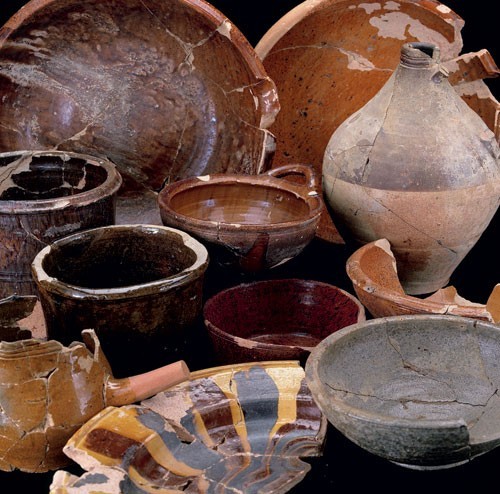
Earthenware and stoneware “wasters” recovered from the William Rogers site in Yorktown, Virginia, ca. 1720–1745. (Courtesy, National Park Service, Colonial National Historical Park, Yorktown Collection; all artifact photos by Gavin Ashworth.)

Photograph showing the initial stages of the excavation of one of several waster pits discovered on the site. (Photo, Norman F. Barka.)
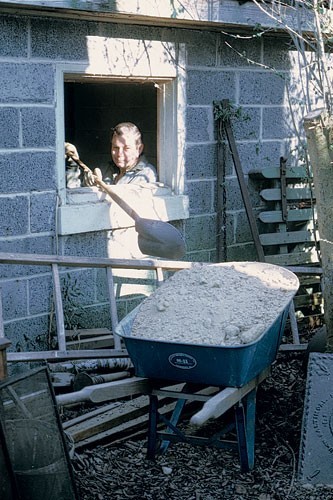
Excavator removing soil from within the car garage over the buried William Rogers’s kiln complex. (Photo, Norman F. Barka.)

View of archaeological excavation of the William Rogers’s pottery complex with portions of the kiln exposed beneath a cinder block garage. (Photo, Norman F. Barka.)
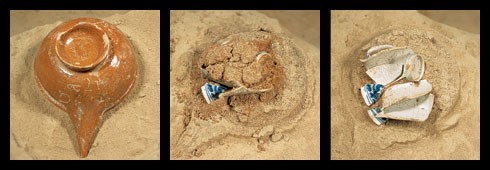
The discovery and excavation of William Rogers’s porringer and London delft capuchinne. (Photos, Norman F. Barka.)
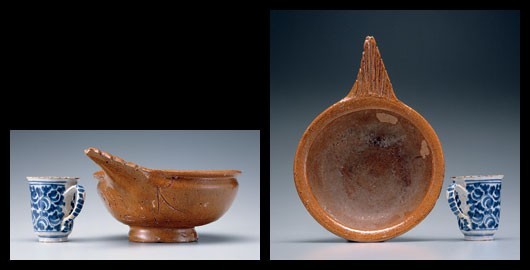
Porringer and coffee cup. Porringer: William Rogers, Yorktown, Virginia, 1720. Lead-glazed earthenware. D. 6 1/2". Coffee cup: London, ca. 1700. Tin-glazed earthenware. H. 2 5/8". (Courtesy, National Park Service, Colonial National Historical Park, Yorktown Collection.) COLO Y 7096, COLO Y 7097. These special objects may represent the material evidence of a dedication rite or ceremony marking the first successful firing of the large kiln. The initials “ag” on the porringer might refer to the initials of the potter, who remains unidentified, and “1720” to the first year of production at the site. The tin-glazed cup, made in London, England, in the period 1700– 1720, would have been especially valued by the potter because of its fine quality; it may also have reaffirmed connections the potter had with the tin-glazing industry in Lambeth or Southwark. In any case, the burial of these pots was likely a special event to ensure good luck in the pottery business. The porringer may be the earliest dated American-made piece ever found in a kiln context.
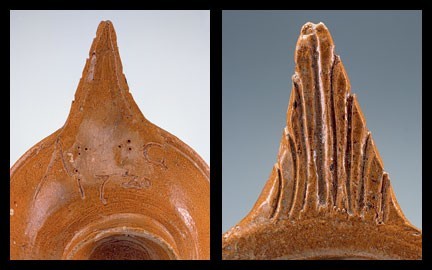
Detail of the back and front of the dedication porringer illustrated in fig. 6. Its solid handle is triangular-shaped with incised parallel line decoration on the upper, flat portion. At least one bisque handle fragment has been found at the site, signifying that the porringer was made at the site.
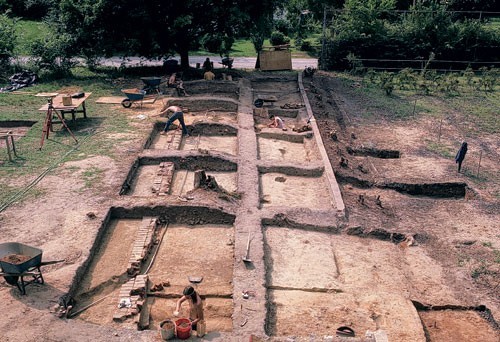
View of the archaeological excavation, facing north. (Photo, Norman F. Barka.) Note the brick foundation of the workshop complex at left.
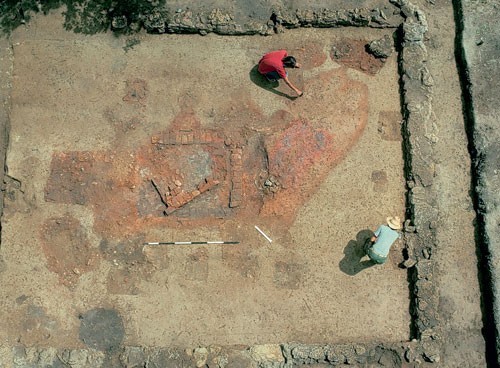
Overhead view of the Small Kiln prior to excavation. (Photo, Norman F. Barka.)
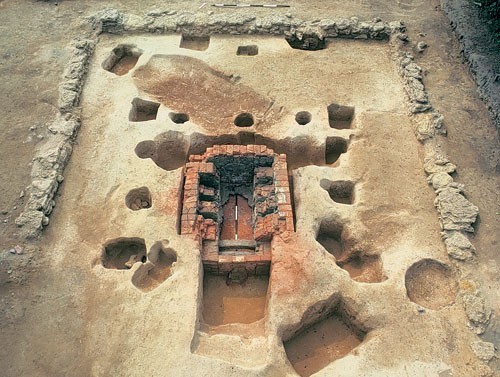
Overhead view of the completed excavation of the Small Kiln. (Photo, Norman F. Barka.) The traces of a marl foundation and a series of postholes represent the remains of the contemporary structures associated with the kiln.
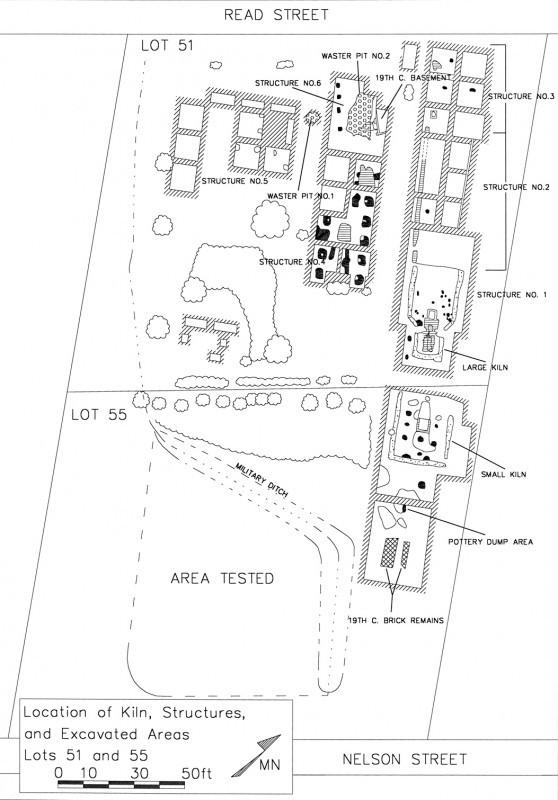
A plan drawing of the excavations detailing the locations of the kilns and related structures and features.
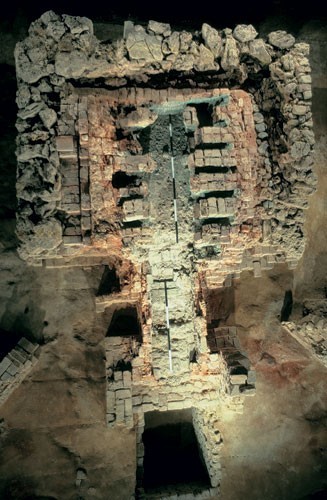
An overhead view of the Large Kiln. (Photo, Norman F. Barka.)
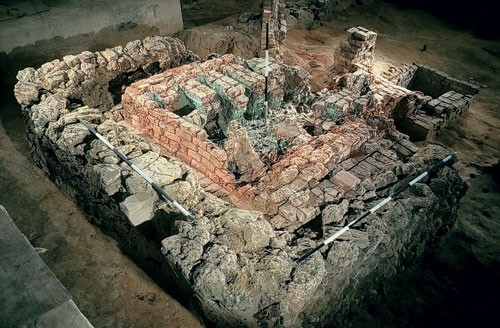
An oblique view of the Large Kiln. (Photo, Norman F. Barka.)
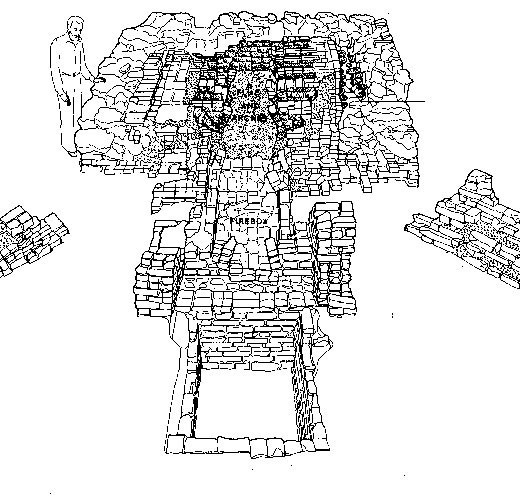
A drawing of the remains of the Large Kiln. (Unless otherwise noted, all drawings courtesy of the Department of Anthropology, College of William and Mary, Williamsburg, Va.)

A cross section of the Large Kiln.
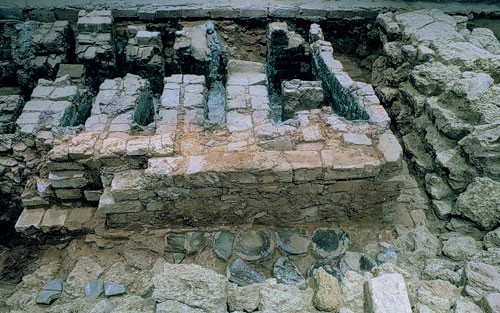
View of the corridor on the west side of the Large Kiln. (Photo, Norman F. Barka.) This area was paved with flat saggar lids, saggar bases, and body fragments. Measuring 1.2 feet wide and 8 feet long, the corridor may have allowed the potter to peer through spy holes in the kiln wall to judge the pot chamber’s temperature.

A view of the excavated Small Kiln, facing south. (Photo, Norman F. Barka.)
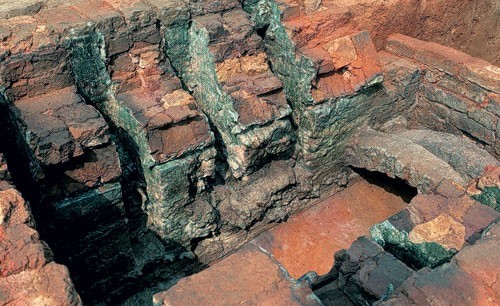
An oblique view of the Small Kiln. (Photo, Norman F. Barka.)
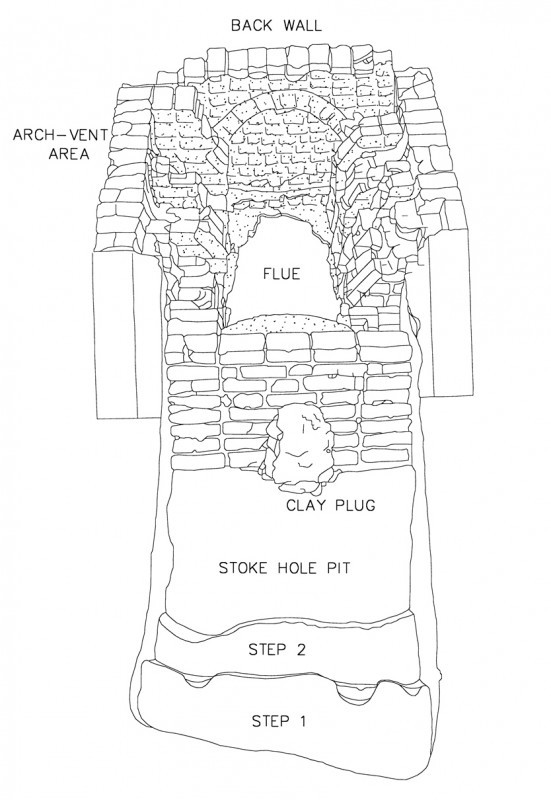
A drawing of the remains of the Small Kiln.
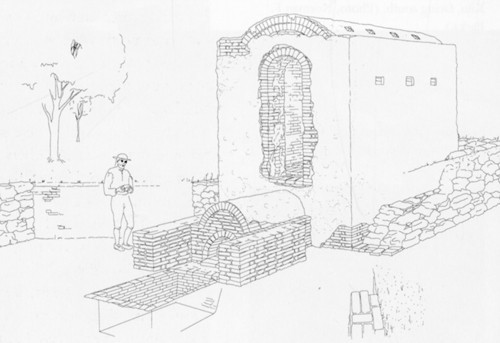
An artist’s reconstruction of the Large Kiln.

An artist’s reconstruction of an English stoneware kiln similar to the type employed at the William Rogers pottery. (Chris Green, John Dwight’s Fulham Pottery: Excavations 1971–79 [London: English Heritage, 1999], fig. 22; drawing © Chris Green.)
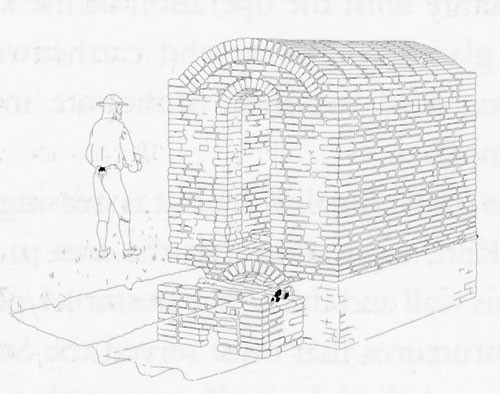
An artist’s reconstruction of the Small Kiln.

Bird bottle, William Rogers, Yorktown, Virginia, 1720–1745. Lead-glazed earthenware. H. 8 1/2". (Courtesy, Department of Archaeological Research, Colonial Williamsburg.) William Rogers’s inventory lists “4 doz bird bottles.”
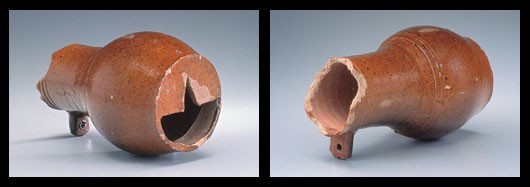
Front and back views of the bird bottle illustrated in fig. 23. Note the perforated tab in the front to seat a dowel, which would serve as a perch. The back of the bottle was cut while the pot was wet (before firing) to provide a notch for hanging under the eaves of a building.
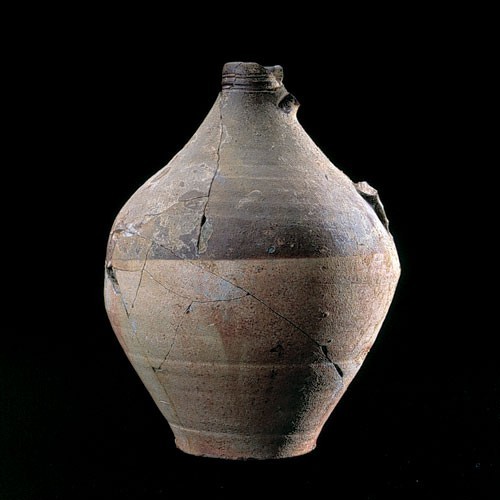
Bottle, William Rogers, Yorktown, Virginia, 1720–1745. Salt-glazed stoneware. H. 10 3/4". (Courtesy, National Park Service, Colonial National Historical Park, Yorktown Collection.) COLO Y71262. In addition to large bottles, a number of fragments from small bottles and flasks (or pocket bottles) were found of the type mentioned in the 1739 inventory. Bottles displayed variation in cordon patterns near the rim, as well as different handle types. A “WR” crown stamp mark is displayed on the shoulder of this example. Capacity seems to vary from one to three gallons, possibly larger.
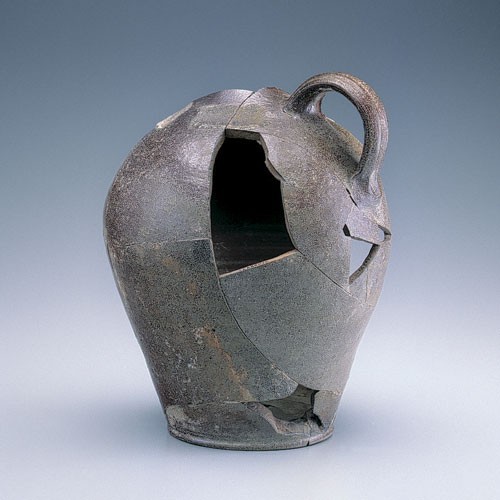
Bottle, William Rogers, Yorktown, Virginia, 1720–1745. Salt-glazed stoneware (lip missing). (Department of Archaeological Research, Colonial Williamsburg.) This example was excavated from an eighteenth-century context in Williamsburg.
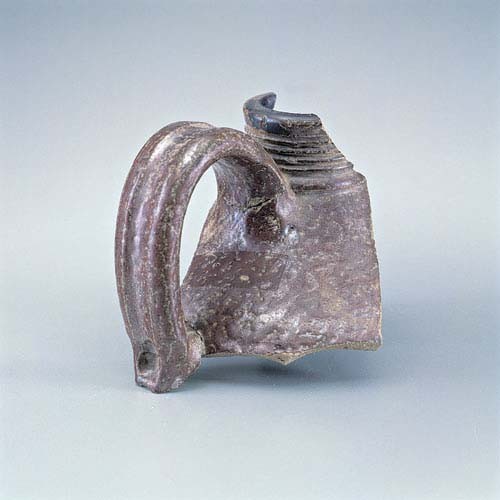
Bottle neck fragment, William Rogers, Yorktown, Virginia, 1720–1745. Salt-glazed stoneware. (Courtesy, National Park Service, Colonial National Historical Park, Yorktown Collection.) COLO Y 15191. This neck fragment is from a large bottle, of three-gallon capacity or possibly more.

Bottle neck fragment, William Rogers, Yorktown, Virginia, 1720–1745. Lead-glazed earthenware. (Courtesy, National Park Service, Colonial National Historical Park, Yorktown Collection.) COLO Y 15616. This large earthenware bottle fragment is covered in a slip and colored with manganese.
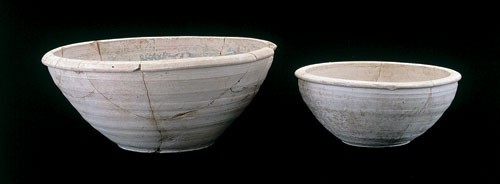
Bowls, William Rogers, Yorktown, Virginia, 1720–1745. Biscuit earthenware. H. 5". (Courtesy, National Park Service, Colonial National Historical Park, Yorktown Collection.) COLO Y 71193, COLO Y 71188. Bowls had up to ten variations in rim style and five basal types. Earthenware forms were fired twice, first to biscuit and then glazed and fired again.

Bowls, William Rogers, Yorktown, Virginia, 1720–1745. Biscuit and lead-glazed earthenware. D. 8 1/2". (Courtesy, National Park Service, Colonial National Historical Park, Yorktown Collection.) COLO Y 71183, COLO Y 71189, COLO Y 71185. Many bowls had a rim diameter of approximately 8", equating to one-quart capacity, although a larger example, with a rim diameter of 20", was excavated.
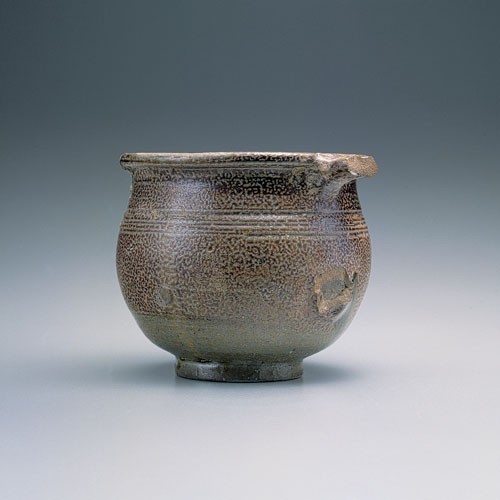
Chamber pot, William Rogers, Yorktown, Virginia, 1720–1745. Salt-glazed stoneware. H. 5 3/4". (Courtesy, National Park Service, Colonial National Historical Park, Yorktown Collection.) COLO Y 14270. Many size variations of both stoneware and earthenware chamber pots were found on the site. A lead-glazed earthenware vessel without handles was recovered that would have served as the receptacle in a closestool.

Chamber pot, William Rogers, Yorktown, Virginia, 1720–1745. H. 5 1/2". Lead-glazed earthenware. (Department of Archaeological Research, Colonial Williamsburg.) This warped and overfired example was recovered from a well in Williamsburg, indicating that Rogers’s seconds had a market.
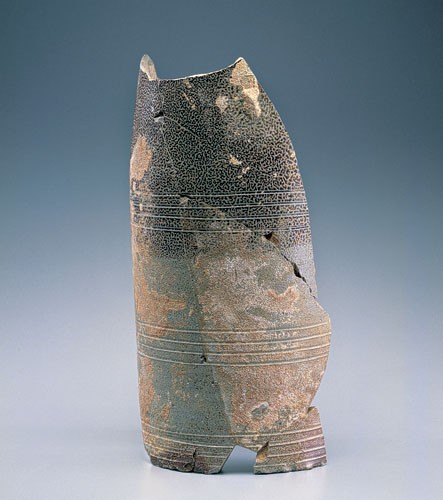
Churn, William Rogers, Yorktown, Virginia, 1720–1745. Salt-glazed stoneware. H. (approx) 17 1/2". (Courtesy, National Park Service, Colonial National Historical Park, Yorktown Collection.) COLO Y 14427a. This tall cylindrical form tapers in circumference from base to mouth. It is one of the few forms to have been decorated with incised leaf and flower motifs. One fragment with a hole in its center may be a churn lid. The Yorktown churns may be the earliest clay butter churns made in America

Detail of rim fragment associated with the churn illustrated in fig. 33. (Courtesy, National Park Service, Colonial National Historical Park, Yorktown Collection.) COLO Y 14427b. Note the heavy iron oxide wash evident on this example.
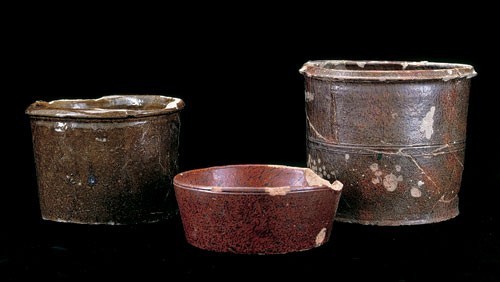
Cream jars and saucepan, William Rogers, Yorktown, Virginia, 1720–1745. Lead-glazed earthenware. H. 4 13/16", 2 3/8", and 7 3/8". (Courtesy, National Park Service, Colonial National Historical Park, Yorktown Collection.) COLO Y 71195, COLO Y 71184, COLO Y 71196.
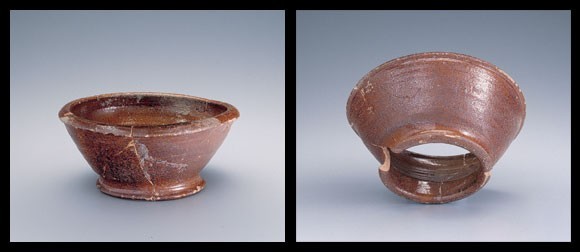
Funnel, William Rogers, Yorktown, Virginia, 1720–1745. Lead-glazed earthenware. H. 4 1/2". (Department of Archaeological Research, Colonial Williamsburg.) This lead-glazed, bowl-like form has two open ends, one smaller than the other for channeling ingredients from one container to the other.

Jar, William Rogers, Yorktown, Virginia, 1720–1745. Lead-glazed earthenware. H. 13 1/2". (Courtesy, National Park Service, Colonial National Historical Park, Yorktown Collection.) COLO Y 71198. Both lead-glazed earthenware and salt-glazed stoneware storage jars were apparently made in large quantities. The heights of the measurable examples range from 71/2" to 17". These heights may conform to a standard range of sizes from one-half gallon up to as large as five gallons.
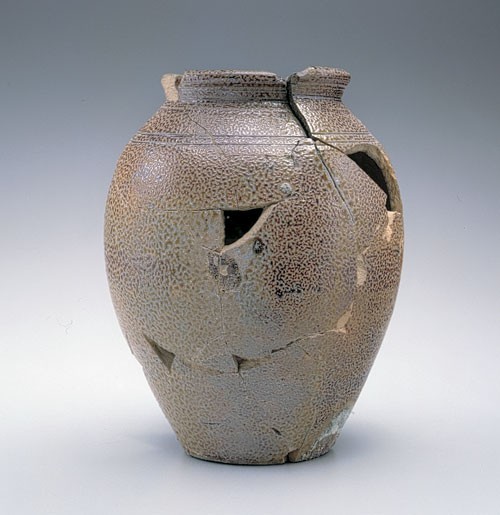
Jar, William Rogers, Yorktown, Virginia, 1720–1745. Salt-glazed stoneware. H. 10". (Courtesy, National Park Service, Colonial National Historical Park, Yorktown Collection.) COLO Y15072. The upper portion of this typical stoneware jar has been dipped in iron oxide. Handles are present only on the largest examples.
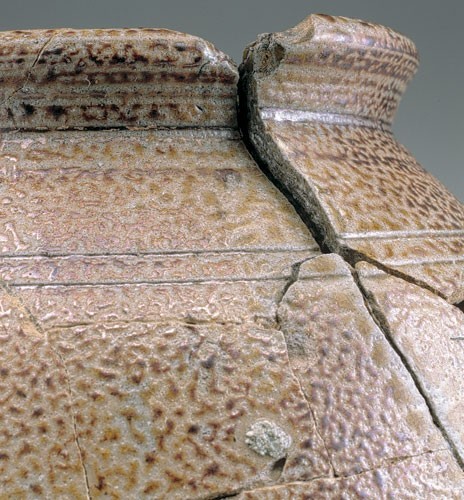
Detail of the jar illustrated in fig. 38. Note the major distortion along the firing crack that helps identify this jar as a waster.

Milk pans, William Rogers, Yorktown, Virginia, 1720–1745. Biscuit and lead-glazed earthenware. D. 13 1/2– 14 1/2". (Courtesy, National Park Service, Colonial National Historical Park, Yorktown Collection.) COLO Y 71251, COLO Y 71253. These wide, flat-based vessels have curved, out-sloping walls and one spout in the rim. While most examples were bisque and lead-glazed earthenwares, a few stoneware milk pans were found. Pans were partially glazed, mostly on the interior, and showed sixteen rim variants. Heights vary from 2–4", with the majority measuring 3 1/2". Rim diameters also vary from 10–19", with the majority measuring 16". Base diameters measure from 6–9".
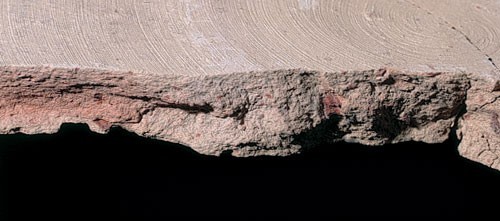
Detail of cross section of the bisque clay body of the milk pan illustrated at left in fig. 40. Note the brick red inclusions of hematite, a characteristic of the Rogers’s pottery earthenware.
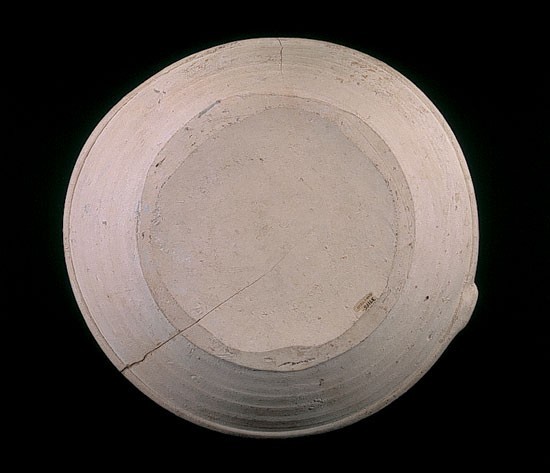
Milk pan, William Rogers, Yorktown, Virginia, 1720–1745. (Courtesy, National Park Service, Colonial National Historical Park, Yorktown Collection.) COLO Y 71220. After throwing, excess clay at the base was cut off with a knife or tool, as indicated by the marks on this example.
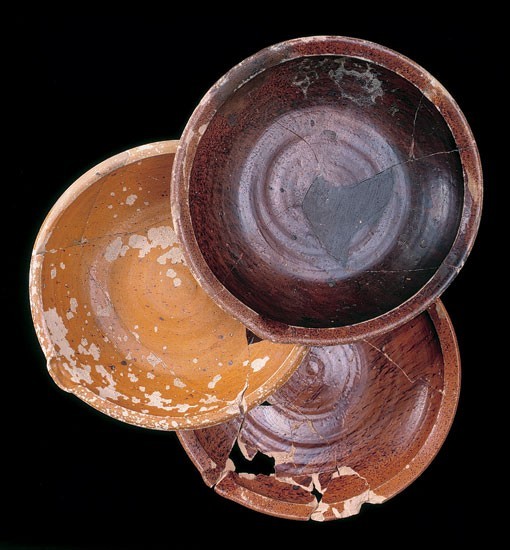
Milk pans, William Rogers, Yorktown, Virginia, 1720–1745. (Courtesy, National Park Service, Colonial National Historical Park, Yorktown Collection.) COLO Y 71191, COLO Y 71252, COLO Y 71199. Note the wide range of color due to variation in the firing environment within the kiln.

Mugs, William Rogers, Yorktown, Virginia, 1720–1745. Salt-glazed stoneware. (Courtesy, National Park Service, Colonial National Historical Park, Yorktown Collection.) One of the most common forms produced by William Rogers was the tavern mug. Bisque and glazed earthenware and stoneware were recovered. Earthenware mugs, yellow in color, were dipped in white slip or finished with a green glaze of dark brown or red-brown. Yorktown stoneware mugs were manufactured in the following sizes a few mug bases, large in diameter, were probably one quart in capacity. The stoneware mug (together with the teapot) was the highest quality pot made by the “poor potter.” Its appearance and excellent potting rivaled those made in England; in fact, more time and care were spent making the Yorktown mugs, as they were the only form fired in saggars. Thirteen small stoneware mugs, each 3 1/2" high and 2 1/2" in diameter, appear to have been test pieces; all were found in association with the Small Kiln. Several show one or more slashlike incisions and some show evidence of a white slip, which in some cases had clearly peeled off the mugs but in others had produced a smooth white “glaze” under the salt glaze.
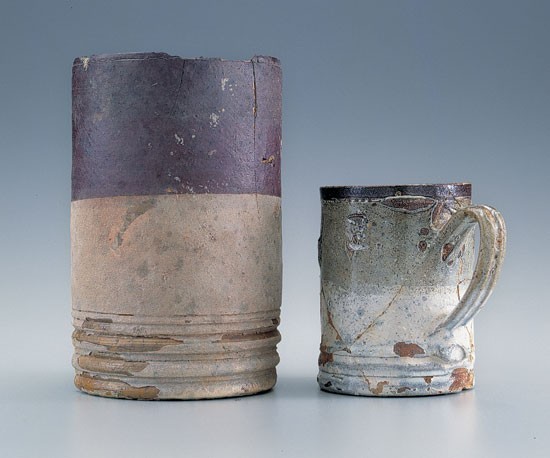
Mugs, William Rogers, Yorktown, Virginia, 1720–1745. Salt-glazed stoneware. H. 5 7/8" and 3 9/16". (Courtesy, National Park Service, Colonial National Historical Park, Yorktown Collection.) COLO Y 71102, COLO Y 10,884. The upper half of a stoneware mug was usually dipped in iron oxide and the lower part was sometimes dipped in white slip. Each mug has one strap handle, with the lower terminal folded back on itself and impressed.

Mug, William Rogers, Yorktown, Virginia, 1720–1745. Salt-glazed stoneware. H. 3 1/2". (Courtesy, National Park Service, Colonial National Historical Park, Yorktown Collection.) COLO Y 47098. Many stoneware mugs are stamped with the initials “wr” beneath a crown, both of which are in relief within a depressed rectangle. The majority of these stamps are located to the left of the handle.
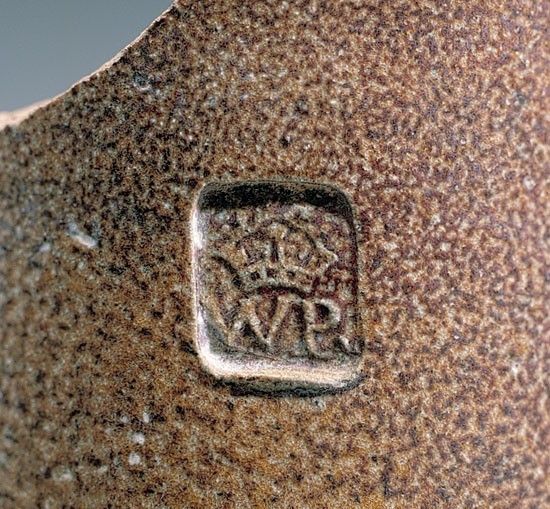
Detail of the “WR” excised mark on the mug illustrated in fig. 46. In 1700, during the reign of William III, regulation of the capacity sizes of tavern mugs was enacted that required vessels to be measured during manufacture and stamped with “WR” below a crown. It is interesting to observe that Rogers continued marking his products even though he was beyond the government’s accountability for his wares. Perhaps these marks helped reassure his tavern keeper clients as to the veracity of the measures.
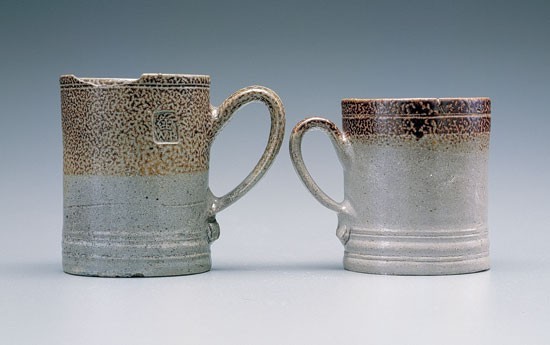
Mugs, William Rogers, Yorktown, Virginia, 1720–1745. Salt-glazed stoneware. H. 3 1/2" and 3 1/8". (Courtesy, National Park Service, Colonial National Historical Park, Yorktown Collection.) COLO Y 7098, COLO Y 7099..
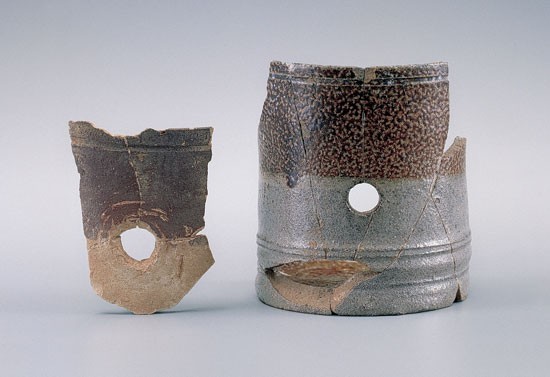
Mug fragments, William Rogers, Yorktown, Virginia, 1720–1745. Salt-glazed stoneware. H. (right) 2 1/2". (Courtesy, National Park Service, Colonial National Historical Park, Yorktown Collection.) COLO Y 10,896, COLO Y 10,942. The function of the holes in these mugs has never been satisfactorily explained, but one suggestion is that they served as trial pieces which could have been extracted from the kiln during firing to check on the quality of glazing.
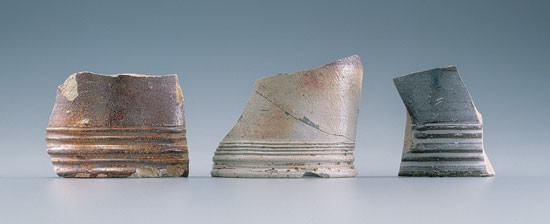
Mug base fragments, William Rogers, Yorktown, Virginia, 1720–1745. Salt-glazed stoneware. (Courtesy, National Park Service, Colonial National Historical Park, Yorktown Collection.) COLO Y 10,927, COLO Y 10,928, COLO Y 10,929. These examples show some of the variation in the cordoning treatment on the base of Rogers’s mugs. At least eleven cordon variations occur on the mugs.
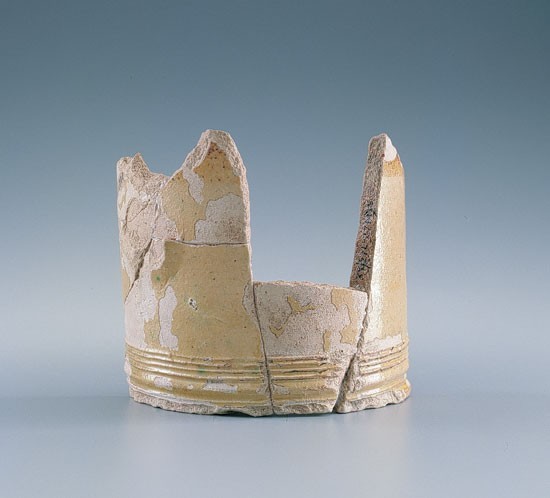
Mug base fragment, William Rogers, Yorktown, Virginia, 1720–1745. Lead-glazed earthenware. Diam. (approx.) 4". (Courtesy, National Park Service, Colonial National Historical Park, Yorktown Collection.) COLO Y 10,919. Some of the earthenware mugs were covered in a white slip before glazing; none yet identified bears the impressed “wr” stamp.

Pipkin, William Rogers, Yorktown, Virginia, 1720–1745. Lead-glazed earthenware. H. 4 1/8". (Courtesy, National Park Service, Colonial National Historical Park, Yorktown Collection.) COLO Y 71194. Earthenware pipkins are cooking pots with a flat base or three legs, bulbous walls with a rim spout, and a solid or open handle applied at an angle. The handles are tapered and pulled, with cut or pinched-off ends. Some pipkins had large, hollow-thrown handles into which a wooden dowel could be inserted. Stonewares are thrown, solid cylinders, measuring 4 1/2" in rim diameter, 3 1/2" at base, and 4 1/2" high. This nearly complete lead-glazed example shows how they were stacked directly on top of each other in the kiln. One footed pipkin, mostly lead-glazed with a wide cylindrical handle, was found in Gloucester Town, an eighteenth-century settlement facing Yorktown across the York River.

Pipkin and bowl, William Rogers, Yorktown, Virginia, 1720–1745. Salt-glazed stoneware. H. of pipkin: 4 1/8". (Department of Archaeological Research, Colonial Williamsburg.) These are examples of Rogers’s domestic stoneware vessels excavated in Williamsburg.
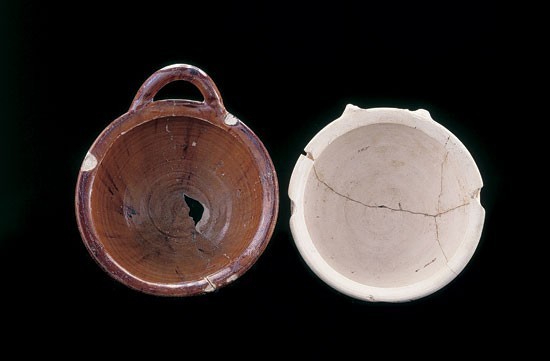
Porringers, William Rogers, Yorktown, Virginia, 1720–1745. Lead-glazed earthenware. Diam. 7". (Courtesy, National Park Service, Colonial National Historical Park, Yorktown Collection.) COLO Y 71190, COLO Y 71182. These bowl-like vessels have a flat base, curved out-sloping walls, flattened and usually down-sloping (toward the interior) rims, and a C-shaped, circular-sectioned handle attached to the rim. As with most of Rogers’s earthenwares, the porringer has a reduced gray-green to red-orange color related to the kiln temperature and the atmosphere in the kiln.
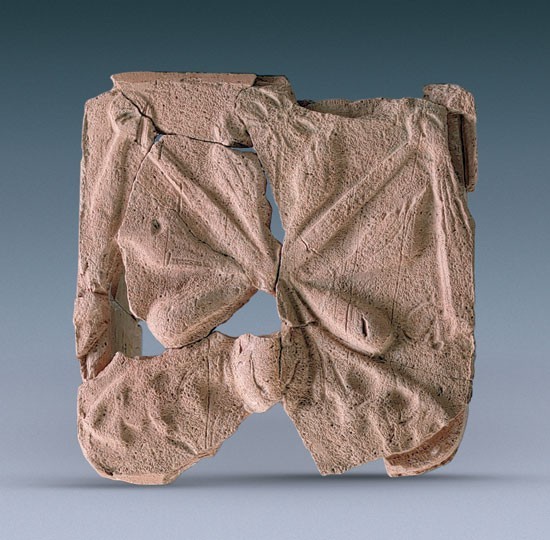
Stove tile, William Rogers, Yorktown, Virginia, 1720–1745. Earthenware. 7" square. (Courtesy, National Park Service, Colonial National Historical Park, Yorktown Collection.) COLO Y 8722a. This square tile has a raised design on one surface and an encircling wall or flange applied at right angles to the back of the flat tile. One-half of a complete specimen and 435 other fragments were found, all bisque; only three glazed fragments were found. The surface of the molded tile is decorated with a swag, six leaves, a pomegranate, and a flower. The total estimated sample found is 44 separate tiles. Stove-tile manufacture in Yorktown suggests the presence of a Dutch or German potter, as tile stoves were popular in Europe during the eighteenth century but not in England. Stove tiles of this type were also made in Moravian areasof North Carolina.

An artist’s clay reconstruction of a William Rogers stove tile. (Courtesy, Patricia Kandle.)

Dish fragments, William Rogers, Yorktown, Virginia, 1720–1745. Slipware. (Courtesy, National Park Service, Colonial National Historical Park, Yorktown Collection.) COLO Y 11490, COLO Y 11450, COLO Y 11854, COLO Y 11566, COLO Y 11853. A number of fragments from large, wide-rimmed low dishes with flat bases were recovered from the site. This form is usually slip-decorated but sometimes plain. The method of slip decoration includes trailing, combing, and marbleizing. These dishes range in diameter from 10–15" (with the majority being 14") and are about 2" high. They have a red to pinkish body, with glazed pieces usually yellow in color. The interior is lead-glazed. No examples of this important ceramic type have ever been found outside of the immediate pottery site.

Dish fragment, William Rogers, Yorktown, Virginia, 1720–1745. Slipware. (Courtesy, National Park Service, Colonial National Historical Park, Yorktown Collection.) COLO Y 71192. This highly unusual slipware dish employed lines of red and black slip trailed over a white ground slip and subsequently joggled to create the marbleized center pattern.
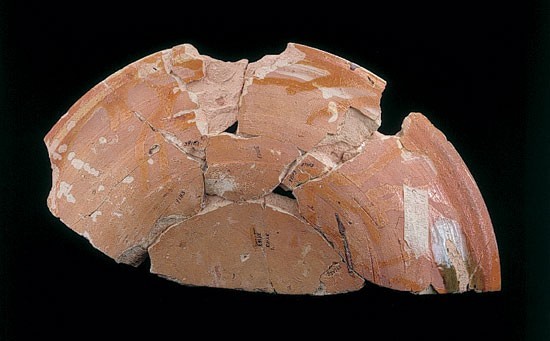
Reverse of the slipware dish fragment illustrated in fig. 58.
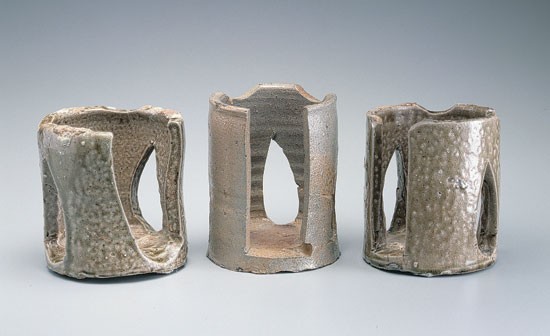
Saggars, William Rogers, Yorktown, Virginia, 1720–1745. H. 5", 5 1/2", and 5". (Courtesy, National Park Service, Colonial National Historical Park, Yorktown Collection.) COLO Y 15928, COLO Y 38766, COLO Y 15934. A variety of saggars were employed at the Rogers’s pottery to protect the stoneware mugs during firing. Made of refractory clay, the Yorktown saggars have four openings cut into the walls, permitting the entrance of heated air and volatilized salt. Three of the openings are teardrop-shaped; the fourth is a wide rectangular slit cut through the rim to facilitate air movement and subsequent removal of the glazed mug. Most saggars are heavily coated with salt glaze because of repeated use. Saggars range in diameter and height from 4–10", although there seem to have been three main sizes (corresponding to the different size stoneware mugs). The largest saggars are 9–10" in height and weigh about 8–10 pounds each. Saggars were stacked in columns in the kiln’s pot chamber. The kiln’s topmost saggar was topped by a lid. Individual saggars and stoneware pots were separated from one another—to prevent sticking during salt glazing—by props, pads, and wads of refractory clay generally referred to as kiln furniture. Thousands of saggar fragments and pieces of kiln furniture were found throughout the site.

Teapot fragments, William Rogers, Yorktown, Virginia, 1720–1745. Salt-glazed stoneware. (Courtesy, National Park Service, Colonial National Historical Park, Yorktown Collection.) COLO Y 37515, COLO Y 9813, COLO Y 9815, COLO Y 9816, COLO Y 9817. In addition to the large variety of coarse utilitarian ware, a number of finely thrown teaware pots were produced. Both lead-glazed and salt-glazed stoneware were found. These pots generally measured 4" high with a rim and basal diameter of 4". No examples of Rogers’s teawares have been identified outside of the pottery site.
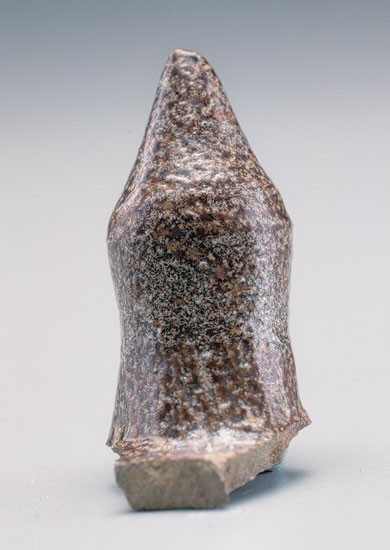
Coffee pot lid knop. William Rogers, Yorktown, Virginia, 1720–1745. Salt-glazed stoneware. (Courtesy, National Park Service, Colonial National Historical Park, Yorktown Collection.) COLO Y 9822. The shape and size of this fragment, based on parallels with English examples of the period, suggest that William Rogers may also have been making coffee pots.

Fragment of a strainer from the interior of a salt-glazed stoneware teapot. (Courtesy, National Park Service, Colonial National Historical Park, Yorktown Collection.) COLO Y 9824.
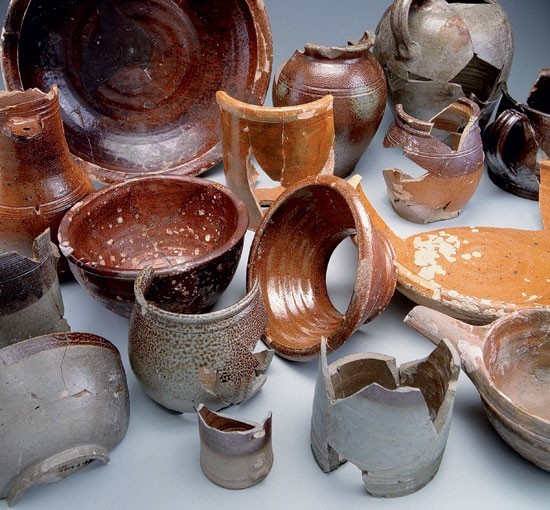
Probable examples of William Rogers earthenwares and stonewares, 1720–1745, excavated in Williamsburg. (Department of Archaeological Research, Colonial Williamsburg.) The success of William Rogers’s pottery can be measured by the widespread distribution of his finished wares. Examples of his utilitarian forms are found at archaeological sites throughout the tidewater region of Virginia, with specimens also being reported from Maryland and North Carolina. Historical evidence suggests his wares may even have reached Caribbean ports.
The discovery in 1966 of the “Poor Potter” manufacturing site in Yorktown, Virginia, is one of the most significant industrial finds in historical archaeology. Excavation of the site has revealed the rare preservation of two kilns and abundant evidence of the production of a large variety of pottery, including the earliest stoneware made in America (fig. 1). The site also stands out historically because of its size and technological advancement in kiln and factory design. The establishment and operation of this well-developed pottery complex was a remarkable industrial achievement. As well, its development clearly flaunted British mercantile policy, especially as Yorktown was located only a short distance from Williamsburg, the seat of British colonial government in Virginia.[1]
Documentary and archaeological evidence of pottery kiln sites—or, indeed, any manufacturing site—is not always easy to find. Such mundane and ordinary structures and activities were rarely recorded by potters or by contemporary citizens, and relatively few kiln sites are known. The relative completeness of the Poor Potter site makes it a valuable tool for the study of kiln technology, pottery production, trade, and early-eighteenth-century consumer demands.
The Identity of the “Poor Potter”
The term “poor potter” is first mentioned in the documentary record by the royal governor of the Virginia colony, William Gooch, in 1732; in subsequent years, until 1741, Governor Gooch sent required reports dealing with trade and manufacture in Virginia to England’s Board of Trade. The content of these reports and other documents was meager at best, and in essence asserted that the government need not worry about damage to English trade because the potter’s work was of little consequence. The last known reference by Gooch was in his 1741 dispatch, in which he mentioned the potter’s death. By the 1950s, archaeological research was providing further evidence of local manufacture of ceramic wares, suggesting that Governor Gooch had made a conscious attempt to disguise Yorktown’s burgeoning industry.[2]
It appears that only one person, William Rogers, can definitively be associated with the Yorktown pottery operation: he was a well-established businessman and entrepreneur in Yorktown during the early eighteenth century; he owned the two lots on which the pottery factory was built; and the inventory of his estate taken at the time of his death in December 1739 lists many items that would have been associated with a pottery operation.[3]
There is little question today that William Rogers was the “poor potter,” but he probably was not a potter and he certainly was not poor. In addition to being a successful brewer and respected businessman (see McCartney and Ayres, “Yorktown’s ‘Poor Potter’: A Man Wise Beyond Discretion,” pp. 49–59 in this issue), there is sufficient evidence to establish that he was the owner of one of the largest, most significant, and most successful pottery factories in colonial America.
William Rogers was born sometime between 1680 and 1688 across the Thames from London in Southwark or Lambeth, major pottery-producing areas in the seventeenth and eighteenth centuries. Although very little information about him survives, there are many families named Rogers who lived in Southwark and Lambeth.
Rogers probably arrived in Yorktown in 1710. Established as a port town in 1691, Yorktown had soon become a thriving community of fifty or more buildings, including homes, storehouses, a church, and a courthouse. Lawyers, merchants, tailors, craftsmen, and blacksmiths were just some of the citizenry making up the town’s permanent residents.
In 1711 William Rogers acquired two half-acre lots, Lots 51 and 55, on the northwest edge of town, where he probably lived until his death in 1739. Since these lots became the eventual site of the pottery factory, Rogers’s proprietorship indicates that he was seriously involved with the pottery operation.
Archaeological excavations of the property turned up the remains of numerous buildings, two kilns, waster pits, and a number of features. Written documentation also speaks. Various court records dating to the 1720s indicate that Rogers sold quantities of earthenwares to various plantations in Virginia and Maryland, among them Marlborough, Menokin, and Wicocomico. And a subsequent owner of the lots, George Chaplin, a butcher, received a deed in 1770 describing them as those “commonly known by the name of the Pothouse lots.”
In 1759, twenty years after Rogers’s death, his daughter, Sarah, listed other structures that were probably situated on the lots, namely a dwelling, a garden, a stable, and a pothouse. Rogers also owned additional property in and around Yorktown, including several ships and a waterfront warehouse, and it is likely that Rogers’s family continued his success and operated his business until at least 1745.
Rogers and British Mercantilism
The British mercantile system of the eighteenth century had as its goal the supply of British manufactured goods to the colonies and the discouragement of any colonial manufacture that would compete with and thereby lessen the need for British exports. The British Board of Trade regulated colonial commerce through the appointed governors of the colonies. Some governors enforced Board of Trade policy, others neglected it. There is no evidence to suggest that the Board of Trade or British pottery manufacturers ever complained about Rogers’s pottery factory or even knew of the prodigious quantities of quality ware that it produced.
Rogers opened the Yorktown pottery works in or around 1720 during the administration of Colonel Alexander Spotswood, who ran the colony from nearby Williamsburg. Governor Spotswood must have known about the enterprise in Yorktown, so his silence on its operation indicates at least tacit approval. Governor Hugh Drysdale succeeded Spotswood in 1722, but he, too, maintained silent approval of the pottery factory.
In 1727 William Gooch, who was sympathetic to home manufacture, became governor of the colony. In contrast to Spotswood and Drysdale, Gooch reported on the activities of a “poor potter” but never mentioned William Rogers by name. The responses by Gooch to queries put forth by the Board of Trade from 1732 to 1742 are both protective and favorable in tone. It is likely that Governor Gooch used the term “poor potter” to mislead the Board of Trade and mask the true nature of the Yorktown pottery industry. “Poor potter” would have implied either an impoverished potter or a potter who produced inferior quality pots. Rogers was neither. He sold not only large quantities of earthenwares but also excellent salt-glazed stoneware vessels, and the mugs he produced are virtually indistinguishable in quality from those produced in England. Gooch had to mention the Yorktown enterprise because of its ever-increasing size and production, but clearly he tried to minimize the operation so as not to alarm the Board of Trade. His reports to the Board of Trade provide an exercise in reading between the lines.
In order to operate an enterprise the size of the Yorktown pottery, Rogers would have needed a large number of skilled and unskilled laborers, and he might have used skilled potters from England and Europe. Evidence shows he used the labor of indentured servants and slaves, some of whom also could have been skilled potters. (See McCartney and Ayres, pp. 51–52.)
Archaeological Research
The William Rogers site was discovered when the author excavated a large waster pit on Lot 51 (fig. 2). From 1966 to 1970, with the help of students from the College of William and Mary and other interested individuals, a testing program was carried out on limited portions of the site. In the fall of 1970, the first of two kilns—designated the “Large Kiln”—was discovered and subsequently excavated (figs. 3, 4). Associated with the Large Kiln were two artifacts purposefully buried as part of a dedication ritual (figs. 5-7). The author recalls the day these incredibly significant objects were uncovered:
The discovery of two well-preserved eighteenth century pottery kilns at the Poor Potter’s site in Yorktown was a rare experience for any historical archaeologist. In addition, the finding of these two extraordinary pots at the same site was downright unbelievable. After thirty years, I still find it difficult to believe, but the story of this adventure is true. On a beautiful, and what was to be a very eventful day in 1970, I drove to Yorktown as I had planned to spend some time defining the back side of the recently discovered large kiln. Troweling the soil in this area revealed a darker pit-like feature measuring about one foot in diameter. After recording it, I began to excavate the feature and my trowel scraped what appeared to be a pottery sherd. Digging farther into the feature, a pottery vessel began to emerge and within a short time a complete pot had been uncovered—a bowl-like porringer, with a triangular handle and raised annular base, completely lead glazed and orange in color, and buried upside down. I could not believe my eyes, but the next discovery was equally thrilling. Brushing the dirt off the exterior surface of the pot below the handle revealed the initials “ag” and the date “1720”; both letters and numbers had been incised into the pot prior to glazing. Lifting the porringer out of the soil matrix revealed another astonishing “treasure,” a small white tin-glazed cup with a handle, exquisitely potted, with blue floral decoration on the exterior and the lip of the rim painted red. After overcoming a sense of exhilaration over these unique discoveries, I thought about the meaning of the extraordinary finds. What a special day it was for both the “poor potter,” who made and buried the pot in 1720, and for me, who found it 250 years later.[4]
Expanded excavations during the summer of 1972, the first to be sponsored on this site by the National Park Service, uncovered the remains of the probable workshop room and buildings interconnected with the Large Kiln (fig. 8).
In the fall of 1975, William and Mary personnel began the excavation of a second kiln, designated the “Small Kiln” (figs. 9, 10). Approximately fifty percent of Lots 51 and 55 have been tested or excavated as of this writing, uncovering two kilns, a workshop building complex, several post-in-the-ground structures, and two waster pits (fig. 11). It is believed that the major components of the pottery factory were uncovered in the archaeological research carried out from 1966 to around 1981.
The Yorktown pottery factory was a large operation, consisting of a symmetrical complex of buildings and features. The main pottery complex probably consisted of a row of interconnected buildings, rooms, and kilns located on the east side of Lots 51 and 55. The complex measures about 170 feet in length (north-south) and 20–22 feet in width, extending from the edge of Read Street to within one hundred feet of Nelson Street. Both the Large and Small Kilns were situated toward the south end. The archaeological and architectural evidence suggests that pots were thrown, dried, and glazed in a large workshop room or rooms and fired in one of the two kilns.
Large Kiln
The Large Kiln was built of brick and marl (figs. 12, 13). Rectangular in shape, it was of the updraft type, with a lower heat chamber and an upper pot chamber (fig. 14). The foundation for the kiln and an adjoining room immediately north of the kiln had been constructed in a large rectangular hole measuring 37 feet by 22 feet to a depth of 4.4 feet below ground surface. The lower one-third or so of the kiln, or the majority of the heat chamber, was situated below ground level, with the pot chamber floor approximately at ground level (fig. 15).
The building (designated Structure 1) directly associated with the kiln is bounded on the south by the kiln, on the east and west by marl walls, and on the north by steps cut into subsoil that lead into a large structure, the presumed main workshop building (designated Structure 2). The Large Kiln is a well-built, well-planned structure, symmetrical in plan. A firebox and stoke hole project from the north side into the center of Structure 1.
The kiln itself measures 21.6 feet by 13.3 feet and, for discussion purposes, can be divided into three parts: flue-arch-vent area; firebox with adjacent stoke-hole pit; and adjacent brick and marl walls and corridor.
The central brick portion of the lower heat chamber consisted of a main flue spanned by arches separated by vents or open areas that circulated hot air. This area also served as a foundation for the pot chamber located directly above. The entire flue-arch-vent area was constructed of red nonfire brick. Vertical brick walls extended upward from the outer portions of this area to contain the heat generated in the firebox, which is connected to the flue on the kiln’s north side. The heat chamber floor was formed by the top of the arch system. The flue-arch-vent area measures 8.5 feet square, exclusive of the firebox and stoke-hole pit, and survives to a height of thirteen courses of brick, or 3.32 feet above sterile soil.
The flue measures 2.2 feet in width by 6 feet in length, its floor sloping gently from south to north, where it connects with a shorter and steeper slope. The total flue-firebox length is 11.7 feet. The flue was formed by a series of six parallel arches, each separated by vents. The arches were catenary in shape, the midpoint of each reaching an estimated height of 3 feet from the flue floor. The arches survive to various elevations, the highest at 1.84 feet above the flue floor. The angle of the arch is currently about 19° inward from the vertical, and both arch and arch supports are one brick wide.
The arches were separated from one another by four-inch vents, which paralleled the six arches across the width of the heat chamber. The vents as well as the arches were positioned at right angles to the flue. Originally extending about one foot into the pot chamber and terminating at the same height as the arches’ upper surface, the vents enabled the flue’s hot air to travel upward into the heat chamber. The maximum surviving horizontal length of the vents is 1.8 feet (east-west). The interior surfaces of the arches and vents are thoroughly coated by a fairly thick layer of bluish green salt glaze, making it impossible to discern interior brick characteristics.
When found, the flue-arch-vent area was filled with a 1.7-foot-deep deposit of soil, artifacts, rubble, and kiln debris, with the majority of finds consisting of kiln furniture. The lower layer probably was contemporary with the kiln’s operation, as a great deal of kiln furniture was present at this level. Finds included numerous props, separators, and pads.
The firebox is the area of the kiln where heat was generated through the combustion of wood logs. Heat traveled into the kiln flue and up through the vents and into the pot chambers. The firebox extended from the kiln’s north side to a stoke-hole pit. Both structures were constructed entirely of brick. The firebox, which connects to the flue, measures the same width, 2.2 feet. It has a flat brick floor and extends for a length of 4 feet, from an arched firemouth on the north to a point where the floor rises at a 37 degree angle to meet the sloping flue floor.
The two parallel walls of the firebox survive to a height of 1.8 feet. Both walls are continuously glazed on the inner (toward the fire) surface. The glaze is coarser than the salt glaze found on the flue-arch-vent surfaces because the intense heat melted the brick. The firebox floor bricks are heavily fire-affected but not glazed. Its walls show evidence of rebuilding, as occasional bricks with glazed surfaces are noticeable on the exterior. The upper brick course of the firebox walls curves slightly inward, suggesting that an arched roof had been in place. When first excavated, a low arched firemouth was present on its north side. The firemouth’s opening measured 1.5 feet in height and 1.2 feet in width. This feature was subsequently destroyed by vandals, although a photographic record survives.
The firebox is flanked on both sides by brick retaining or support walls. Each wall is laid in Flemish bond and is 1 1/2 bricks wide, surviving to a maximum of 2.6 feet high, or twelve courses of brick. The walls are each 4 feet in length and do not extend the full span of the firebox. Each wall’s north end extends about 1.8 feet beyond the firemouth, forming boundaries for a short brick platform, which continues between the firemouth and stoke-hole pit. Unlike the firebox bricks, the platform bricks are not glazed by heat. Measuring 4 feet long and 1.4 feet wide, the platform served as a small loading and utility area between the stoke-hole pit and firemouth.
To the immediate north of the firebox, and separated by the platform, there is a stoke-hole pit, a brick-walled box with a dirt (subsoil) floor. The pit’s floor as found is nearly 2 1/2 feet below the level of the firebox floor. By standing in the hole, the potter could more easily load logs into the firebox and stoke the fire. It also may have served as a temporary repository for the hot coals and ash raked out from the firebox through the firemouth. When found, the stoke-hole pit contained numerous strata of ash. The pit may have served one other function: if the kiln’s temperature became too high, the fire could be drawn or raked out through the stoke hole into the stoke-hole pit, thereby reducing the temperature.
The stoke-hole pit is slightly trapezoidal in plan, the end nearest the firebox slightly narrower than the opposite (north) end. The pit measures 4 feet in length and 2.65 feet in height. All four walls were built of thirteen courses of red brick, but survive to heights varying between nine and eleven courses. The firebox fill, platform area, and stoke-hole pit consisted of strata of rubble, ash, and numerous examples of kiln furniture.
The flue-arch-vent area, made entirely of brick, is flanked on three sides by a continuous wall of irregular marl blocks, probably quarried from the cliffs of the nearby York River. Extending to 3.47 feet in height, 1.5–2.5 feet in width, and 10.4–13.3 feet in length, it may have functioned as an insulating barrier between the heat chamber and the ground.
On the south and east sides, the marl walls directly articulate with the outer walls of the flue-arch-vent area. On the west side there is a corridor paved with flat saggar lids, saggar bases, and body fragments (fig. 16). Measuring 1.2 feet wide and 8 feet long, the corridor may have allowed the potter to peer through spy holes in the kiln wall to judge the pot chamber’s temperature.
Small Kiln
A smaller kiln was found about 23 feet south of the Large Kiln. It, too, is well preserved due to the presence of a below-ground heat chamber (fig. 17). However, the upper pot chamber, originally situated above ground level, has been destroyed. The Small Kiln has a Bourry-like firebox, differing slightly from the Large Kiln, which has an extended firebox.[5] Nonetheless, both are similar in basic design—updraft kilns with an upper pot chamber resting on a lower heat chamber. The Small Kiln measures 12.7 feet by 5.75 feet and consists of a lower heat chamber made entirely of brick, a stoke-hole pit with earthen steps leading into it, and filled builders’ trenches (fig. 18). It, like the Large Kiln, had been built into a hole dug three feet into the subsoil. The present archaeological remains are well preserved to a maximum height of 2.9 feet, or twelve to thirteen courses of brick.
The heat chamber has maximum dimensions of 7.1 feet (north-south) by 5.5 feet. The chamber consisted of outer brick walls, interior arch supports, and arches designed to promote heat circulation through flues and an interior firebox area (fig. 19). The north wall contains a stoke hole. Brickwork, for the most part, was laid in random bonding patterns. The south wall exhibits numerous salt-glazed headers. Four arches supported the pot chamber floor above, and a fifth arch within the south wall probably served to strengthen the kiln’s rear wall. The stoke hole in the north wall was found plugged with a clay slab on its exterior side; the interior portion of the stoke hole had been plugged with eight brickbats.
The chamber’s interior contained four arch supports and flue arches, four minor flues, a main flue, and two lower arches that formed the firebox area, all of which were heavily salt-glazed. The main flue is 2 feet wide and extends from the north wall to the south wall, a distance of 5.8 feet. At right angles to the main flue and on each side are four smaller flues, each 0.4 feet wide. These eight flues, essentially spaces between brick arches, were passages through which hot air circulated in the main flue-firebox area and entered the upper pot chamber.
In addition to the flues, four brick arches once spanned the main flue, each arch supported by seven to eight courses of brick. Arches were separated from one another by the minor flues, a distance of 0.4 feet. The vertical dimension of the main flue was about 2.1 feet, and the pot chamber’s floor was about 2.5 feet above the kiln’s lowest part. The kiln’s firebox is defined by two completely preserved brick arches, situated between arch 1 and the kiln’s north wall, and two ledges above the arches on the side walls of the kiln.
The kiln was approached using two earthen steps formed in an excavated hole on the north side. At the bottom the potter had a small area from which to load wood onto the firebox ledges and to rake ashes out of the kiln. When found, the kiln and stoke-hole pit were filled with brick rubble and soil. A lower ash level, contemporary with the operation of the kiln, contained fragments of bisque and glazed stoneware and earthenware, indicating that both might have been fired together. Stoneware mugs made up the majority of the small sample.
A marl wall is present on three sides of the Small Kiln, but is missing on the fourth side that faces the Large Kiln, suggesting that the area in between was accessible to both kilns. This wall and thirty-five postholes/postmolds represent the remains of the structures that once served the Small Kiln. Those situated immediately around the kiln itself suggest that the Small Kiln was braced by wooden logs. A system of vertical, horizontal, and, perhaps, angling logs may have supported the kiln from movement caused by the heating and cooling brick. The kiln and bracing posts were flanked on three sides by a 24-foot-square structure represented by low marl walls and postholes/postmolds. This structure undoubtedly supported a cover to protect the Small Kiln from rain. The Large Kiln also must have been protected from the elements, but postholes were not discerned and may have been destroyed during the construction of the modern garage.
Both Yorktown kilns were similar in design and construction. Each had below-ground heat chambers incorporating a series of arches and vents that regulated heat flow while simultaneously supporting the pot chamber floor above. The Large Kiln was the major production unit at the factory. Based on the heat chamber’s size and shape, the Large Kiln’s stacking area is estimated at 310 cubic feet, a good-sized kiln (fig. 20). The kiln was fired by shoving logs through the small arched firemouth or stoke hole located on the north side of the firebox. The pot chamber entrance was also located on the north side, since that faces both the workshop room and building. It is probable that a movable wooden stairway was built over the firebox area, providing access to the pot chamber doorway, which was bricked up before each firing. The Large Kiln roof was arched and contained slots or holes for heat and smoke escape (fig. 21). The roof must have looked like the kiln drawn by Piccolpasso in 1548.[6]
The Small Kiln had a capacity roughly one-quarter the size of the Large Kiln, and was estimated at 80 cubic feet (fig. 22). A Bourry-like firebox was formed by a shorter and narrower projection of the kiln’s north side. Two brick shelves or hobs, each one brick wide, flanked either side of the main flue. Located slightly below these shelves were two arches, beneath which is a stoke hole. The brick shelves supported the ends of the logs, which served as fuel. Air could pass easily beneath the burning logs and combustion could take place in the firebox. The primary air would enter at or near the top of the firebox and flames would travel downward and enter the firebox arch. Embers fell into the area below, but an intact secondary grate formed by two smaller arches below the hob on the kiln’s north side would catch and suspend any partially burnt wood for more complete combustion. This firebox was quite sophisticated for its time.
Other Buildings and Features
As previously mentioned, there are several possible workshop buildings connected with the Large Kiln. A workshop room (Structure 1) was delineated by marl foundation walls 2 feet wide and 19 feet long. The subsoil floor situated some 4 feet below ground surface survives to a height of only 0.8 feet. Originally, these walls probably reached upward at least to ground level. The room measures 23 feet (north-south) by 17.5 feet. Its southern boundary is determined by two yellow brick walls, each angling inward about 45 degrees toward the Large Kiln to which they once articulated.
Structure 1 may have served as an area in which a variety of tasks were performed—stacking wood for burning, storing pots before firing, and, perhaps, carrying out the final glazing or dipping operations, as evidenced by eighteen maroon-colored soil stains in the subsoil floor surface. A volume of about 1,584 cubic feet of brick rubble and pottery was excavated in this room. All fill represents post-fill debris, materials deposited there once the pottery factory had ceased operation.
Structure 2 was a building with interior dimensions of 54 feet by 17 feet that connected with the north end of Structure 1. Only the west wall is extant because of recent disturbances to the area. The west brick wall of Structure 2 is 54 feet long and, given the symmetry of the factory complex, the east wall would have had the same dimensions. The higher floor level of Structure 2 gradually merges with the lower Structure 1 floor through a stepped slope carved into the subsoil. It is likely there were wooden steps or a ramplike structure for easy access between the two rooms. No evidence of a fireplace was found in Structure 2, giving further credence to the belief that Structures 1–3 were actually interconnected units of one long building. In summary, Structure 2 was a long building of the same width as Structure 1; because it had been disturbed, however, its function is difficult to interpret.
Evidence regarding Structure 3 is similarly incomplete because portions of the building have been destroyed. At this layer, light gray clay covers an area that measures 17 feet by 8 feet. One of the more interesting characteristics was a layer of white ash, immediately below which were four ash-filled postmolds (each 0.3 feet square) connected to one another by narrow, shallow ash-filled trenches. Measuring 3 feet square, it may represent the former location of a wooden clay working or throwing table or bench, or perhaps a potter’s wheel.
Archaeological excavations revealed Structure 4 approximately 17 feet east of Structures 1 and 2. This post-in-the-ground building measured 32 feet (north-south) by 16 feet. The wooden building could have been another workshop/storage building or even a dwelling. There were many additional eighteenth- and nineteenth-century finds, as the entire extent of Lots 51 and 55 was covered with below-ground archaeological remains: several waster pits filled with large quantities of mostly broken pottery; the remains of at least one additional post-in-the-ground structure; a brick-lined basement with a bulkhead entrance; evidence of plow scars; and various trash pits.
Ceramics
The “Poor Potter” factory produced large quantities of utilitarian pottery over a period of approximately twenty-five years. Both lead-glazed earthenwares and salt-glazed stonewares were made in a variety of shapes. About 140,000 sherds were studied from the Yorktown site. Earthenware was more prevalent than stoneware. The number of bisque and glazed sherds found was nearly equal, giving credence to the importance of two separate firings of wares. Bisque stoneware, however, occurred more frequently than glazed earthenware by three to one, possibly signifying more breakage during bisque firing. Although the presence of bisque stoneware on the site is significant, its frequency in relation to glazed stoneware is low. Most sherds found were body fragments, but the shape of nearly 68 percent of the sherds found could not be identified, leaving the main study sample of 32 percent (45,374 sherds). Of this amount, 42 percent (18,932) was kiln furniture.
Analysis of the identifiable sherds disclosed a minimum of twenty-three forms (figs. 23-27). Of these, twenty-one were produced in earthenware, fifteen in stoneware. Ten forms were produced in either earthenware or stoneware and thirteen forms were made in both wares. Nearly all the shapes were found in both bisque and glazed varieties. Milk pans constituted nearly 40 percent of the identified sherds. Mugs were the second most frequent form, followed by bottles, bowls, storage jars, platters, pipkins, and cream pots.
The shapes produced range from coarse utilitarian, lead-glazed milk pans with knife-trimmed bases to delicate, finely thrown, salt-glazed teapots with expertly turned lids. The potters were well experienced in the craft, as is evident from the quality of the kilns and ceramic products. However, the lack of relative dating evidence eliminates the possibility of knowing what forms were produced contemporaneously.
The products of the Yorktown pottery can be grouped into the following functional categories:
Food processing. Pipkins or cooking pots; saucepans (possibly used for cooking puddings, pastries, etc.); bowls (for preparing foods); milk pans (used in cream collection); colanders (for washing vegetables, making cheese); churns (for making butter).
Food and drink storage. Storage jars and bottles (for storage of solid foods [jars] or liquids); cream pots may have been used to store butter and other foods.
Beverage consumption. Mugs were made in several different sizes.
Beverage serving. Handled jugs and teapots.
Food consumption–serving. A variety of porringers, plates, and chargers were probably utilized as food receptacles.
Health/hygiene. Chamber pots were the only known vessels to be used in this category.
Other vessels. Bird bottles, betty lamps, funnels, and chafing dishes.
Many technological and artistic innovations can be found in the products of the Rogers pottery; indeed, there is much evidence of experimentation, as a number of actual test pots were found. A variety of small bisque earthenware pots, approximately eighty in number, were found in a dump area near waster pit 2. The pots vary between 3 and 5 inches in rim diameter and between 1 and 2 inches in height. The majority have numerals or initials crudely incised into the upper surface of each pot. Surface treatments and colorations are highly sophisticated, paralleling the best use of materials by London and Staffordshire potters. The potters used calcined flint in either the body slip or the glaze, dipping their mugs in a white slip to cover the dark body. Copper green glazes were used on at least twelve forms. Of particular importance are the large slip-decorated dishes employing a variety of techniques, including combing, trailing, and marbleizing.
The Yorktown churns were perhaps the first to be made in America. Unusual forms such as bird bottles, chafing dishes, colanders, and funnels show sound design for specific purposes. Robust forms, such as large, footed pipkins, have a peasant quality. Other forms—thin, cordoned mugs and delicate teapots with tight-fitting lids—show technical excellence.
Of tantamount importance is the evidence that William Rogers conducted America’s first successful salt-glazed stoneware firings. At the Rogers site it seems that earthenwares and stonewares were fired in the same kiln. One significant discovery is the low firing temperature of hard-bodied stonewares. Apparently stonewares were fired in a range between C/06 (1,005˚ centigrade) and C/1 (1,125˚ centigrade), which is a temperature well within the firing range for coarse earthenware. The potters may have been using a refined earthenware body that became dense and mature and, therefore, well-salted at this low temperature. Earthenware clays are common in most areas of Yorktown, and undoubtedly this was one reason for establishing the pottery factory in or near the town. The source of stoneware clay, however, remains unknown.
With the exception of stove and floor tiles, which were mold-made, all Yorktown wares were formed or thrown on a potter’s wheel. Most earthenware forms were glazed on both the interior and exterior. Eleven earthenware vessel forms were finished with a green lead glaze. It has been estimated that the Large Kiln would have required about 155 pounds of salt per firing and the Small Kiln about 40 pounds.
Close observation of pots and sherds found at the site reveals clues to kiln stacking methods. Since kiln shelving has not been found, wares had to be stacked. For example, milk pans were stacked on edge, in a series, one leaning against the other. At most, they were glazed only on the interior to just over the rim, so the glazed rim of the pan behind would rest on the unglazed back of the pan in front. The rims of some bisque milk pans have glaze adhering to their underside, indicating alternate bisque and glazed stacking. Bowls, porringers, and pipkins were stacked upside down on top of and overlapping one another, as shown by stacking scars. Bottles and storage jars were traditionally stacked base to base and rim to rim in columns.
In salt glaze firings, it was necessary to use a method that would keep pots from fusing together, since volatilized salt covers everything in the kiln. Kiln furniture—saggars, flat pads and wads, and cylinders or props—was made and used for this purpose. It is probable that the only forms fired in saggars were mugs and possibly teapots.
As for the horizontal distribution of the site’s pottery finds, the main factory complex—Small Kiln, Large Kiln, and Structures 1, 2, and 3—produced the overwhelming majority of pottery (116,000 sherds, or ninety percent of those sherds classified by provenance).
Conclusions
It is unfortunate that we know so little about the people who participated in this industrial enterprise. However, it seems probable that there was a strong Yorktown–London connection in kiln design in what has been called the tin-glaze pattern kiln.[7] Excavations of kilns at Norfolk House, Montague Close, Vauxhall, and Fulham provide evidence of rectangular kilns in which tin-glazed earthenware and stonewares had been fired.[8] The use of rectangular kilns for tin glazing goes back at least to Piccolpasso in 1548.[9] His rectangular kiln also resembles the Yorktown kilns in basic design: a lower heat chamber with a system of flues and arches beneath a pot chamber, which was bricked up during firing.
John Dwight of Fulham used a rectangular kiln for stoneware manufacture in the late seventeenth century. In the eighteenth century, rectangular kilns were gradually supplanted by circular bottle kilns, as the Vauxhall evidence indicates. Based on the English archaeological evidence, there is no doubt that the prototype for the Yorktown rectangular kilns was English.
The Yorktown kilns may be linked to the same English tin-glazing-to-stoneware tradition. The Yorktown potter(s) may have come from the London area and probably had worked in the Lambeth-Fulham vicinity. Perhaps this link with tin-glazed pottery explains the burial of the blue-on-white tin-glazed cup beneath the “1720” porringer. The cup was undoubtedly an object of sentimental value that would, it was hoped, bring good luck to the pottery operation.
The Yorktown potter may have influenced the development of other rectangular kilns in America. There are documentary references to a stoneware pottery operating in Lamberton, New Jersey, in the 1770s. In 1778, William Richards, a Philadelphia merchant, advertised for a stoneware potter. The pottery ceased to exist in 1787, the year Richards died. His updraft kiln seems to resemble the Yorktown kilns, measuring 14.5 feet by 8.5 feet with a firebox protruding an additional 3 feet at each end. Most of the kiln’s upper chamber floor (8.5 by 3 feet in plan) survived intact.[10]
It is now a certainty that William Rogers was the “poor potter” of Yorktown, but, contrary to his appellation, he was not poor. From 1720 to 1745, Rogers and his heirs financed and operated the largest colonial pottery factory in America. He was an entrepreneur who also might have been a knowledgeable potter. If not the potter, he hired experienced potters whose high level of expertise can be seen in the well-built kilns, factory design, and size of the site, as well as in the products themselves, including finely made stonewares. Whether Rogers was a potter, an entrepreneur, or both, the politics of running a successful business in eighteenth-century Virginia required considerable skill.
ACKNOWLEDGMENTS
I am grateful to all of the people who worked on this project, and it is unfortunate they are too numerous to be listed here. I would like to extend special thanks to Dean Bailey, however, who first showed me the supposed site; Malcolm Watkins and Ivor Noël Hume, who took an early interest in the “poor potter”; and J. C. Harrington, who arranged the first funding for excavation of the site. J. Palin Thorley visited the site many times, much to my benefit. Edward Ayres, Pattie Kandle, Linda Merrill, Chris Sheridan, and Shearon Vaughn contributed greatly to the final report to the National Park Service, as did Toni Gregg with her superb kiln reconstructive drawings. My three sons—Eric, David, and Daniel—spent many weekends at the site, excavating huge quantities of pottery. Andy Edwards, Jimmy Smith, and others did excellent fieldwork at the site, as did numerous anthropology students. Both David Riggs and Bill Pittman were very helpful in obtaining the photographs by Gavin Ashworth for this article. I am also grateful to David Orr for his support through the years. Finally, I am thrilled to have this article published in this very fine journal, skillfully edited by former William and Mary student Rob Hunter.
The initial discovery of the “Poor Potter” site was a waster pit on Lot 51, which contained numerous whole and partial pots, usually defective in some manner. It was not until 1970 that a kiln was found nearby. See the following reports: Norman F. Barka, “The Kiln and Ceramics of the ‘Poor Potter’ of Yorktown: A Preliminary Report,” in Ceramics in America, edited by Ian M. G. Quimby (Winterthur, Del.: Winterthur Museum, 1972), pp. 291–18; Norman F. Barka and Chris Sheridan, “The Yorktown Pottery Industry, Yorktown, Virginia,” Northeast Historical Archaeology 6, nos. 1–2 (1972); Erwin N. Thompson, The Poor Potter of Yorktown, Colonial National Historical Park, Virginia, Historic Structure Report, nps 836 (Denver: Denver Service Center, Historic Preservation Team, National Park Service, 1974); Norman F. Barka, Edward Ayres, and Christine Sheridan, The “Poor Potter of Yorktown”: A Study of a Colonial Pottery Factory, Colonial National Historical Park, Virginia, 3 vols. (Denver: U.S. Department of the Interior, National Park Service, 1984).
C. Malcolm Watkins and Ivor Noël Hume, The “Poor Potter” of Yorktown (Washington, D.C.: Smithsonian Institution Press, 1967).
Items linking Rogers with the “poor potter,” taken from the Inventory and Appraisal of William Rogers the Estate, December 17, 1739, include:
1 pr. large Scales & Weights £2.10 a pcel crakt redware £2 a parcel crakt Stone Do £5 11 pocket bottles 3/8 barrel Gun powder £2.10 1 old Sain & ropes £1.10 1 horse Mill £8 2300 lb. old Iron £9.11.8 26 doz qt Mugs £5.4 60 doz pt Do 7.10 11 doz Milk pans £2.4 9 large Cream potts 4/6 9 Midle Sized Do 3/ 12 Small Do 2 2 doz red Saucepans 4/ 2 doz porringers 4/ 6 Chamber potts 2/ 4 doz bird bottles 12/ 3 doz Lamps 9/ 4 doz small stone bottles 6/ 4 doz small dishes 8/ 6 doz puding pans 2/ 26 Cedar pailes £2.12 40 Bushels Salt £4
A total of 1,511 pottery vessels are listed in the inventory.
Personal communication with Rob Hunter, 2004.
The term Bourry box is derived from Emile Bourry, A Treatise on Ceramic Industries: A Complete Manual for Pottery, Tile and Brick Manufacturers (London: Scott Greenwood and Son, 1911). Emile Bourry described a firebox arrangement where the fuel is placed in an upper opening to rest on brick hobs. As the wood burns, the embers fall into the ash pit, providing continuous upward heat. The air supply, from an upper opening, moves first through the burning wood and then the ash pit before it enters the ware chamber.
Cipriano Piccolpasso, The Three Books of the Potter’s Art, facsimile of 1548 ed., translated and edited by Bernard Rackham and Albert Van de Put (London: Victoria and Albert Museum, 1934).
Chris Green, John Dwight’s Fulham Pottery: Excavations 1971–79, Archaeological Report, no. 6 (London: English Heritage, 1999): 28.
Brian J. Bloice, “Norfolk House, Lambeth: Excavations at a Delftware Kiln Site, 1968,” Post-Medieval Archaeology 5 (1972): 99–159; Graham J. Dawson, “Two Delftware Kilns at Montague Close,” London Archaeologist 1, no. 10 (1971): 228–31; Roy Edwards, “The Vauxhall Pottery, History and Excavations, 1977–81,” London Archaeologist 4 (1981–82): 130–36, 148–54; Green, John Dwight’s Fulham Pottery, pp. 21–28.
Piccolpasso, Three Books of the Potter’s Art.
Richard Hunter, “Eighteenth-Century Stoneware Kiln of William Richards Found on the Lamberton Waterfront, Trenton, New Jersey,” in Ceramics in America, edited by Robert Hunter (Hanover, N.H.: University Press of New England for the Chipstone Foundation, 2001), pp. 239–43.
